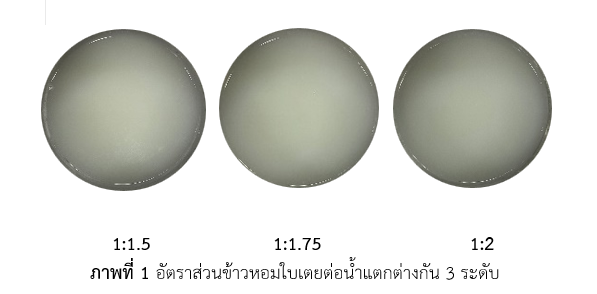A study of the appropriate Palatyne in drink from Hom Bai Tioe rice
Main Article Content
Abstract
The research aimed to study the optimal palatyne in the Hom Bai Tioe
Rice drink product. The study examined three different ratios of Hom Bai Tioe Rice to water: 1.5, 1:1.75, and 1:2 (w:w), and conducted sensory evaluation using a 9-point hedonic scale. The most accepted formula was further investigated by adding different levels of palatyne: 1%, 3%, and 5% by weight, followed by sensory evoluation analysis. The most accepted Hom Bai Tioe Rice drink formula was then analyzed for its nutritional value. The results showed that the optimal ratio of Hom Bai Tioe Rice to water was 1:2 (w:w), which received the highest overall preference score of 7.23. When studying the addition of different levels of palatine, it was found that adding 3% palatyne yielded the highest scores in terms of taste preference and overall preference, with scores of 7.06 and 7.23, respectively. An analysis of nutritional value of the Hom Bai Tioe Rice drink containing 3% palatyne revealed that a 100-milligram serving provided 43.57 kilocalories of energy, with protein, carbohydrates, and moisture content at 0.96%, 10.00%, and 96.97%, respectively. The findings suggest that Hom Bai Tioe Rice can serve a food ingredient and contribute to the creation of health-focused food recipes.
Article Details
References
กรมส่งเสริมการเกษตร. (2554). สถิติการเพาะปลูกข้าวนาปี. กระทรงเกษตรและสหกรณ์.
กล้าณรงค์ ศรีรอต และเกื้อกูล ปิยะจอมขวัญ. (2546). เทคโนโลยีของแป้ง (พิมพ์ครั้งที่ 3). สำนักพิมพ์มหาวิทยาลัยเกษตรศาสตร์.
กล้าณรงค์ ศรีรอต และเกื้อกูล ปิยะจอมขวัญ. (2550). เทคโนโลยีของแป้ง (พิมพ์ครั้งที่ 4). สำนักพิมพ์มหาวิทยาลัยเกษตรศาสตร์.
จุฑามาศ ถิระสาโรช และเฉลิมพล ถนอมวงค์. (2558). การผลิตเครื่องดื่มเพื่อสุขภาพจากข้าวหอมนิล. [วิทยานิพนธ์มหาบัณฑิต]. มหาวิทยาลัยเทคโนโลยีราชมงคลล้านนา.
นิธิยา รัตนาปนนท์. (2553). เคมีอาหาร (พิมพ์ครั้งที่ 4). โอเดียนสโตร์.
นิอร ชุมศรี และศุภศิษฎ์ อรุณรุ่งสวัสดิ์. (2559). การพัฒนาเครื่องดื่มจากข้าวไรซ์เบอรี่เสริมงาดำ. วารสารมหาวิทยาลัยคริสเตียน, 22(3), 340-351.
เบญจวรรณ ฤกษ์เกษม. (2561). วิทยาการข้าวไทย. ศูนย์บริหารงานวิจัยคณะเกษตรศาสตร์ มหาวิทยาลัยเชียงใหม่.
รัตนาภรณ์ ฤทธิแสง. (2559). ผลิตภัณฑ์น้ำชะครามพร้อมดื่ม. [วิทยานิพนธ์มหาบัณฑิต]. มหาวิทยาลัยเทคโนโลยีราชมงคลพระนคร.
ราณี สุรกาญจน์กุล, ปกรณ์ อุ่นประเสริฐ และชำนาญ เจริญรุ่งเรือง. (2549). การผลิตน้ำนมข้าวที่มีคุณค่าทางโภชนาการ. วารสารอาหาร, 36(1), 75-84.
รุจิรา สัมมะสุต. (2552). หลักการปฏิบัติด้านโภชนบำบัด (พิมพ์ครั้งที่ 3). สุพัตราการพิมพ์.
ศยามล เนตรนภา. (2544). การพัฒนาเครื่องดื่มข้าวหอมกลิ่นใบเตย. [วิทยานิพนธ์มหาบัณฑิต]. มหาวิทยาลัยเกษตรศาสตร์.
สำนักวิจัยเศรษฐกิจการเกษตร. (2562, 7 มกราคม). สถานการณ์โคนมโลกไทย ปี 2562. Dairy Development Program. http://dairydevelopmentprogram.weebly.com
สุทธินี สีสังข์, จารุวรรณ วิชัยพรหม และจันทร์เพ็ญ ขํามิน. (2563). การพัฒนาคุณภาพของบะหมี่ปลากึ่งสําเร็จรูปจากปลานิล. [เอกสารวิชาการฉบับที่ 4/2563]. กองวิจัยและพัฒนาเทคโนโลยีอุตสาหกรรมสัตว์น้ำ กรมประมง.
อภิชา เชี่ยวเวช. (2561). การศึกษาการใช้น้ำตาลทรายหญ้าหวานบางส่วนทดแทนน้ำตาลทรายในผลิตภัณฑ์ขนมกุบ. [วิทยานิพนธ์มหาบัณฑิต]. มหาวิทยาลัยเทคโนโลยีราชมงคลพระนคร.
อภิรดา รินพล, เนตรชนก หลวงแสน และพิมพร ดอนมูล. (2554, 1-4 กุมภาพันธ์). การพัฒนาผลิตภัณฑ์เครื่องดื่มจากธัญพืช [เอกสารนำเสนอ]. การประชุมทางวิชาการของมหาวิทยาลัยเกษตรศาสตร์ ครั้งที่ 49, กรุงเทพฯ.
อรนาฎ มาตังคสมบัติ และพนิดา ธัญญศรีสังข์. (2562). สารให้ความหวานแทนน้ำตาลกับผลต่อสุขภาพร่างกายและสุขภาพช่องปาก. วิทยาสารทันตแพทยศาสตร์, 69(4), 379-397.
อรพิน เกิดชูชื่น, ณัฎฐา เลาหกุลจิตต์, พร้อมลักษณ์ สรรพ่อค้า และสุภัทร์ จันทร์วรชัยกุล. (2545). การผลิตเครื่องดื่มเลียนแบบนมจากธัญพืช. วารสารอาหาร, 32(3), 200-212.
AOAC. (2019). Offcial Methods of Analysis of AOAC International. USA: AOAC International.
Arai, L., Britten, N., Popay, J., Roberts, H., Petticrew, M., Rodgers, M., & Sowden, A. (2007). Testing methodological developments in the conduct of narrative synthesis: a demonstration review of research on the implementation of smoke alarm interventions. Evidence and Policy, 3(3), 361-383.
Cheetham, P.S., Imber, C.E., & Isherwood, J. (1982). The formation of isomaltulose by immobilized Erwinia rhapontici. Nature, 299(5884), 628-631.
Lina, B.A.R., Jonker, D., & Kozianowski, G. (2002). Isomaltulose (Palatinose®): a review of biological and toxicological studies. Food and Chemical Toxicology, 40(10), 1375-1381.
Nutrition Labeling. (1993). A guide for developing and using databases (1993rded., pp.119) United States. Food and Drug Administration.
Omueti, O. & Ajomale, K. (2005). “Chemical and sensory attributes of soy-corn milk beverage.” Journal of Biotechnol, 4(6), 847-851.
Ooshima, H., Sakata, M., & Harano, Y. (1983). Adsorption of cellulase from Trichoderma viride on cellulose. Biotechnology and Bioengineering, 25(12), 3103-3114.
SME Thailand Club. (2566, 22 สิงหาคม). นวัตกรรมความหวานพาลาทีนน้ำตาลทางเลือกเพื่อสุขภาพฝีมือคนไทย ที่โรงพยาบาลนำไปใช้อย่างแพร่หลาย. Entrepreneur. https://www.smethailandclub.com/entrepreneur/9227.html
Zerbe, L. (2013). 11 Weird Things Sugar's Doing to Your Body. Hearst Magazine Media.

